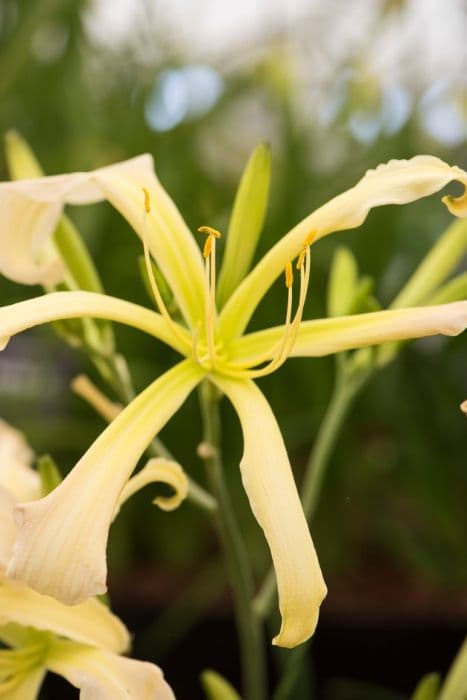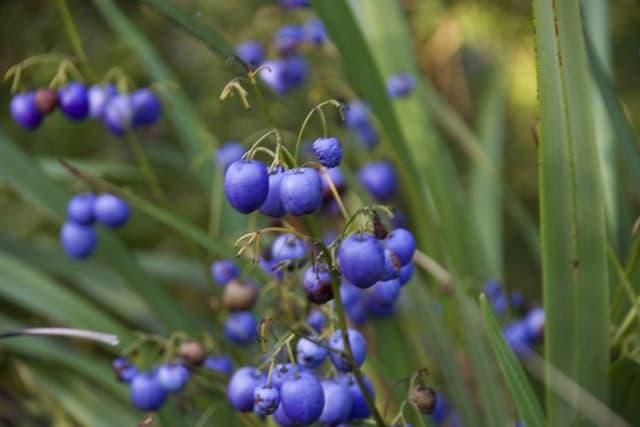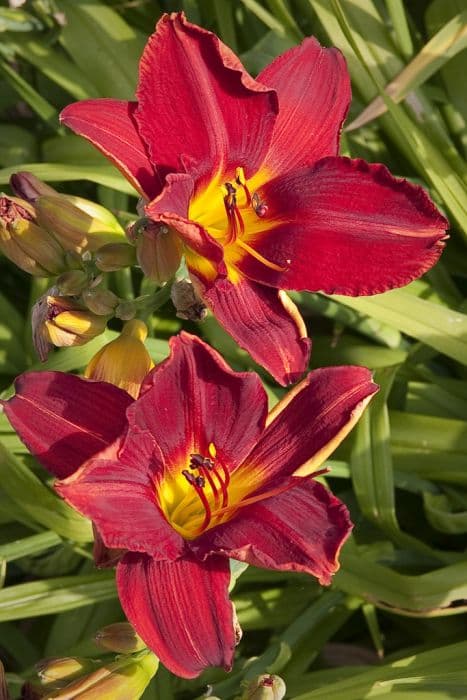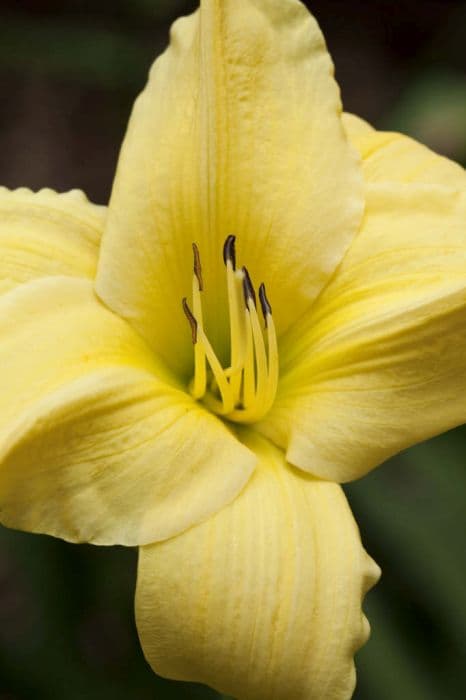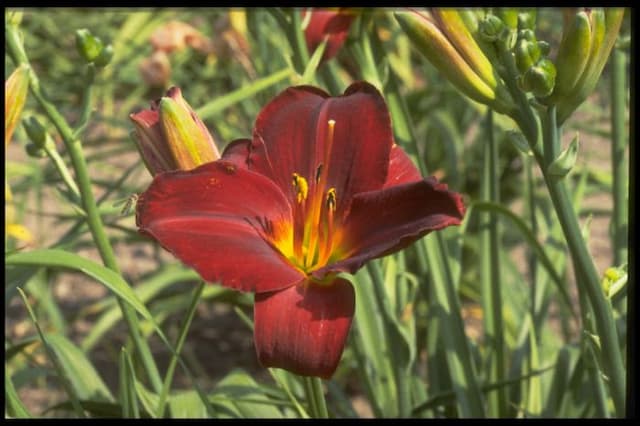New Zealand Flax Phormium 'Blondie' (PBR) (v)
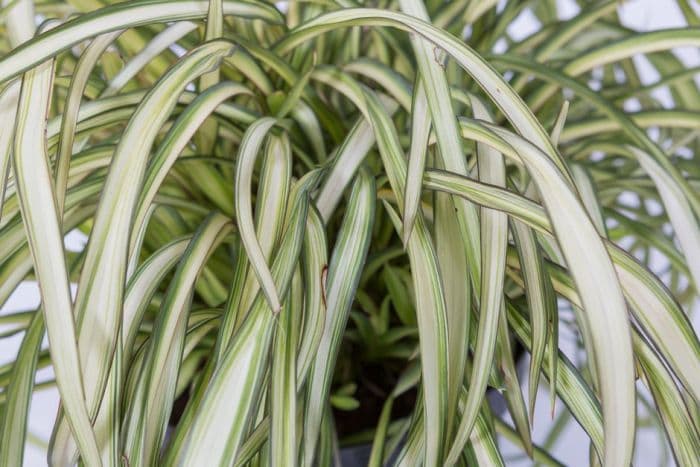
ABOUT
Phormium 'Blondie', commonly known as New Zealand Flax, is a striking perennial known for its variegated foliage. The plant features narrow, upright leaves that arch elegantly from a central clump. Each leaf is characterized by its cream to pale yellow color, edged with green margins, creating a gorgeous contrast. This variegation pattern gives the plant a light and airy appearance. The leaves are typically long and sword-like, with a slightly leathery texture, presenting a dramatic visual interest in the garden throughout the year. New Zealand Flax is not just appreciated for its foliage; it also produces flowers. The bloom stalks rise above the foliage, and although modest, the flowers add an additional layer of appeal to the plant's overall appearance. The foliage often displays a gentle sway when caught by the breeze, providing a dynamic element to its look. This visual appeal makes Phormium 'Blondie' a popular choice for gardeners looking to add texture and color to their landscape.
About this plant
 Names
NamesFamily
Asphodelaceae
Synonyms
New Zealand Flax, Dwarf Mountain Flax
Common names
Phormium 'Blondie' (PBR) (v)
 Toxicity
ToxicityTo humans
New Zealand Flax ('Phormium 'Blondie' (PBR) (v)') is not commonly regarded as a toxic plant to humans. However, it is always prudent to be cautious with plants not typically used for consumption. Ingesting parts of this plant is not advised, and if done so accidentally, it could potentially cause mild stomach upset. It's not known for having severe toxic effects if ingested by humans, but if symptoms do appear after ingestion, it is recommended to consult a medical professional.
To pets
New Zealand Flax ('Phormium 'Blondie' (PBR) (v)') is also not known to be significantly toxic to pets. However, as with humans, the ingestion of non-food plants can sometimes lead to gastrointestinal discomfort or irritation. If a pet ingests a part of the plant and exhibits unusual symptoms or behavior such as vomiting, diarrhea or drooling, it is recommended to contact a veterinarian. While not severely poisonous, cautious monitoring is advisable if pets are known to chew on houseplants.
 Characteristics
CharacteristicsLife cycle
Perennials
Foliage type
Evergreen
Color of leaves
Variegated
Height
2 feet (0.6 meters)
Spread
2 feet (0.6 meters)
Plant type
Shrub
Hardiness zones
8
Native area
New Zealand
Benefits
 General Benefits
General Benefits- Decorative Foliage: Phormium 'Blondie', also known as New Zealand Flax, features striking yellow-green variegated leaves that add a decorative touch to any landscape or garden.
- Drought Tolerant: Once established, it is quite tolerant of dry conditions, making it suitable for water-conservative gardens.
- Low Maintenance: This plant requires minimal care once established, making it ideal for gardeners looking for low-maintenance landscaping options.
- Coastal Resilience: Phormium 'Blondie' is resistant to salt spray, making it an excellent choice for coastal gardens.
- Pest Resistant: It is relatively resistant to pests, reducing the need for chemical treatments.
- Architectural Form: Its upright, sword-like leaves provide an architectural form that can be used as a focal point or to add structure to a planting scheme.
- Mixed Plantings: It works well in mixed beds, borders, and container plantings, contributing to the diversity and visual interest of garden compositions.
- Wildlife Support: The plant can provide shelter for small wildlife and its flowers are a nectar source for birds and insects.
- Versatility: New Zealand Flax can be planted in a variety of soil types and environmental conditions, exhibiting adaptability to different garden settings.
 Medical Properties
Medical PropertiesThis plant is not used for medical purposes.
 Air-purifying Qualities
Air-purifying QualitiesThis plant is not specifically known for air purifying qualities.
 Other Uses
Other Uses- Textile production: New Zealand Flax fibers can be used to create high-quality textiles, such as hand-woven baskets, mats, or clothing items, due to their strength and durability.
- Floral arrangements: The long, striking leaves of New Zealand Flax can add dramatic height and architectural structure to floral arrangements and are favored by florists for this purpose.
- Garden Art: Its unique form and color variances can be used as a living sculpture in garden design, providing focal points and contrasting textures.
- Erosion control: The strong root system of New Zealand Flax can help stabilize slopes and prevent soil erosion in at-risk areas.
- Edging: It can be used as a natural edging plant to define borders within a garden or along pathways, serving as a living fence that offers a well-defined shape.
- Habitat creation: New Zealand Flax can provide shelter and building materials for nesting birds, particularly in New Zealand where some native species use the leaves for this purpose.
- Water features: When planted around ponds or water features, New Zealand Flax can create a natural-looking aquatic environment and help maintain bank stability.
- Windbreak: The tough, leathery leaves of New Zealand Flax can act as a barrier against strong winds when planted as a hedge or in a shelterbelt.
- Companion planting: It can be used as a companion plant to provide a backdrop or contrast for flowering plants, enhancing overall garden aesthetics.
- Film and photography: The distinctive look of New Zealand Flax can be used as a setting or prop in filmmaking and photographic shoots to create an exotic ambiance or represent specific locales.
Interesting Facts
 Feng Shui
Feng ShuiThe New Zealand Flax is not used in Feng Shui practice.
 Zodiac Sign Compitability
Zodiac Sign CompitabilityThe New Zealand Flax is not used in astrology practice.
 Plant Symbolism
Plant Symbolism- Resilience: Phormium, also known as New Zealand Flax, is a hardy plant that symbolizes the ability to withstand tough conditions and bounce back from adversity.
- Versatility: With its various uses in fabric, weaving, and even as a food source historically by the Māori people, New Zealand Flax represents adaptability and resourcefulness.
- Beauty and Grace: The 'Blondie' variety, with its cream-yellow foliage, often signifies elegance and natural beauty due to its strikingly unique and attractive appearance.
- Strength: The tough, fibrous leaves of the New Zealand Flax symbolize inner strength and integrity.
 Water
WaterNew Zealand Flax 'Blondie' requires consistent moisture, but it's also important to avoid overwatering. Aim to water the plant deeply once a week, providing about 1 gallon of water each time. During the hot summer months, you may need to water twice a week if the soil dries out quickly. In winter, reduce watering to every other week or less, depending on the climate and indoor heating conditions. Always check the top inch of soil for dryness before watering to ensure the plant actually needs more moisture.
 Light
LightNew Zealand Flax 'Blondie' prefers a spot with full sun to partial shade. This means it thrives best with at least 6 hours of direct sunlight daily, but it can also tolerate some light afternoon shade. Avoid deep shade as it will not allow the plant to flourish and may lead to poor growth and color.
 Temperature
TemperatureNew Zealand Flax 'Blondie' can tolerate a wide range of temperatures but prefers to be in conditions between 65 and 75 degrees Fahrenheit. It can survive minimum temperatures down to about 20 degrees Fahrenheit, making it resilient to mild frosts. However, prolonged exposure to temperatures below freezing can be damaging, so ensure to provide protection or move it indoors during harsh winter conditions.
 Pruning
PruningNew Zealand Flax 'Blondie' requires minimal pruning to remove any dead or damaged leaves and to maintain its shape. The best time for pruning is in the late winter or early spring before new growth starts. You can also prune in the summer if necessary to remove any spent flower stalks. Prune no more than one-third of the plant at a time to prevent stress.
 Cleaning
CleaningAs needed
 Soil
SoilNew Zealand Flax 'Blondie' prefers well-draining, fertile soil with a slightly acidic to neutral pH, around 5.5 to 7.5. A recommended soil mix could include loam, peat or compost, and coarse sand or perlite to improve drainage.
 Repotting
RepottingNew Zealand Flax 'Blondie' should be repotted every 2-3 years or when it becomes root-bound. This will typically be in the spring before the growing season begins.
 Humidity & Misting
Humidity & MistingNew Zealand Flax 'Blondie' tolerates a wide range of humidity levels but thrives best in moderate to high humidity environments.
 Suitable locations
Suitable locationsIndoor
Place in bright light, avoid cold drafts, and let soil dry between watering.
Outdoor
Choose a sunny spot, protect from frost, and ensure soil drainage.
Hardiness zone
8-11 USDA
 Life cycle
Life cyclePhormium 'Blondie', commonly known as New Zealand Flax 'Blondie', begins its life cycle when seeds germinate in the spring, requiring well-draining soil and adequate warmth. The plant then enters a growth stage, wherein its distinctive, variegated, sword-like leaves develop and mature, forming an attractive, upright clump. As it reaches maturity, which may take several years, Phormium 'Blondie' can produce tall flower spikes in summer, bearing tubular flowers that are attractive to birds and insects. Following pollination, seed capsules develop and, upon ripening, they release seeds for dispersal, completing the reproductive cycle. In the absence of flowering, vegetative propagation through division of the clump can occur, allowing the plant to spread and form new individuals. Throughout its life, Phormium 'Blondie' is an evergreen perennial, with the older leaves eventually dying back at the base to make room for new growth.
 Propogation
PropogationPropogation time
Spring-Early Summer
Propogation: Phormium 'Blondie', commonly known as New Zealand Flax, is typically propagated through division. The best time to propagate this plant is in the spring or early summer, when the plant is actively growing. To propagate by division, carefully dig up the plant and use a sharp, sterile knife or spade to divide the root ball into sections, ensuring that each section has at least one growing point or fan of leaves. Replant the divisions at the same depth they were growing at previously, and water thoroughly. It's important to keep the newly planted divisions well-watered until they are established, which usually means maintaining evenly moist soil for several weeks during the initial growth period.
